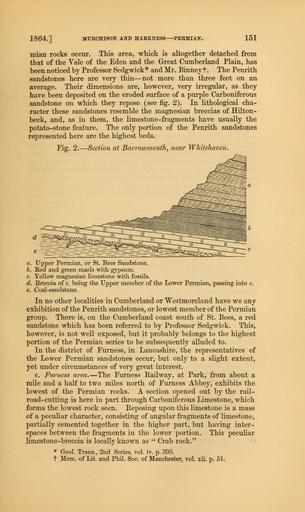MAKE A MEME
View Large Image

| View Original: | The_Quarterly_journal_of_the_Geological_Society_of_London_(12894977463).jpg (1226x2061) | |||
| Download: | Original | Medium | Small | Thumb |
| Courtesy of: | commons.wikimedia.org | More Like This | ||
| Keywords: The Quarterly journal of the Geological Society of London (12894977463).jpg 1864 <br> MTJRCHISON AND HARKNESS PERMIAN <br> 151 <br> mian rocks occur This area which is altogether detached from <br> that of the Yale of the Eden and the Great Cumberland Plain has <br> been noticed by Professor Sedgwick and Mr Binney f The Penrith <br> sandstones here are very thin ” not more than three feet on an <br> average Their dimensions are however very irregular as they <br> have been deposited on the eroded surface of a purple Carboniferous <br> sandstone on which they repose see fig 2 In lithological cha- <br> racter these sandstones resemble the magnesian breccias of Hilton- <br> beck and as in them the limestone-fragments have usually the <br> potato-stone feature The only portion of the Penrith sandstones <br> represented here are the highest beds <br> Fig 2 ” Section at Barrowmouth near Whitehaven <br> a Upper Permian or St Bees Sandstone <br> b Red and green marls with gypsum <br> c Yellow magnesian limestone with fossils <br> d Breccia of e being the Upper member of the Lower Permian passing into c <br> e Coal-sandstone <br> In no other localities in Cumberland or Westmoreland have we any <br> exhibition of the Penrith sandstones or lowest member of the Permian <br> group There is on the Cumberland coast south of St Bees a red <br> sandstone which has been referred to by Professor Sedgwick This <br> however is not well exposed but it probably belongs to the highest <br> portion of the Permian series to be subsequently alluded to <br> In the district of Furness in Lancashire the representatives of <br> the Lower Permian sandstones occur but only to a slight extent <br> yet under circumstances of very great interest <br> c Furness area - ” The Furness Eailway at Park from about a <br> mile and a half to two miles north of Furness Abbey exhibits the <br> lowest of the Permian rocks A section opened out by the rail- <br> road-cutting is here in part through Carboniferous Limestone which <br> forms the lowest rock seen Reposing upon this limestone is a mass <br> of a peculiar character consisting of angular fragments of limestone <br> partially cemented together in the higher part but having inter- <br> spaces between the fragments in the lower portion This peculiar <br> limestone-breccia is locally known as Crab rock <br> Geol Trans 2nd Series vol iv p 395 <br> t Mem of Lit and Phil Soc of Manchester vol xii p 51 36089392 111261 51125 Page 151 Text v 20 http //www biodiversitylibrary org/page/36089392 1864 Geological Society of London Biodiversity Heritage Library The Quarterly journal of the Geological Society of London v 20 1864 Geology Periodicals Smithsonian Libraries bhl page 36089392 dc identifier http //biodiversitylibrary org/page/36089392 smithsonian libraries Information field Flickr posted date ISOdate 2014-03-03 Check categories 2015 August 26 CC-BY-2 0 BioDivLibrary https //flickr com/photos/61021753 N02/12894977463 2015-08-26 16 52 51 cc-by-2 0 PD-old-70-1923 The Quarterly journal of the Geological Society of London 1864 Photos uploaded from Flickr by Fæ using a script | ||||